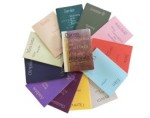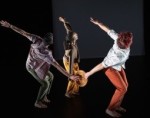Embodying Marks: Dance Notation and Scores in Conversation
by Emilee Lord
"We envision information in order to reason about, communicate, document, and preserve that knowledge...how to reduce the magnificent four-dimensional reality of time and three-space into little marks on paper flatlands." – Edward R Tufte in Envisioning Information.
Fifteen years ago, I submitted my master's thesis to Cranbrook Academy of Art. The broad topic was histories and forms of notation (music and dance), the written word, and drawing. To this day, I discuss how our experiential existence turns into marks and how this carries meaning. For example, in writing, the idea is to record the value of the language in a way that can turn back into the spoken word. Abstraction in drawing records value but without the turn back. For me, dance notation oscillates somewhere in between these two spaces.
I stumbled across Portable Dances Volume 1 and 2 (published in 2021 and 2022), edited by Beth Megill, and it sent me back to my study of dance notation and these idea threads of language, sign, and symbol, particularly regarding scores and performance. The following is a selection of recent conversations with a long-time friend and fellow movement artist Brendan McCall about these volumes, scores for performance, and Motif Description Notation. This article functions as a review of the work of Megill et al. and as a discourse that I hope might spark some play, critique, drawing, and dance-making. What are these books? Who are they for, and where do they land in the history of score-making overall? We started with our expectations and thought, "Oh, interesting! Let's play!”
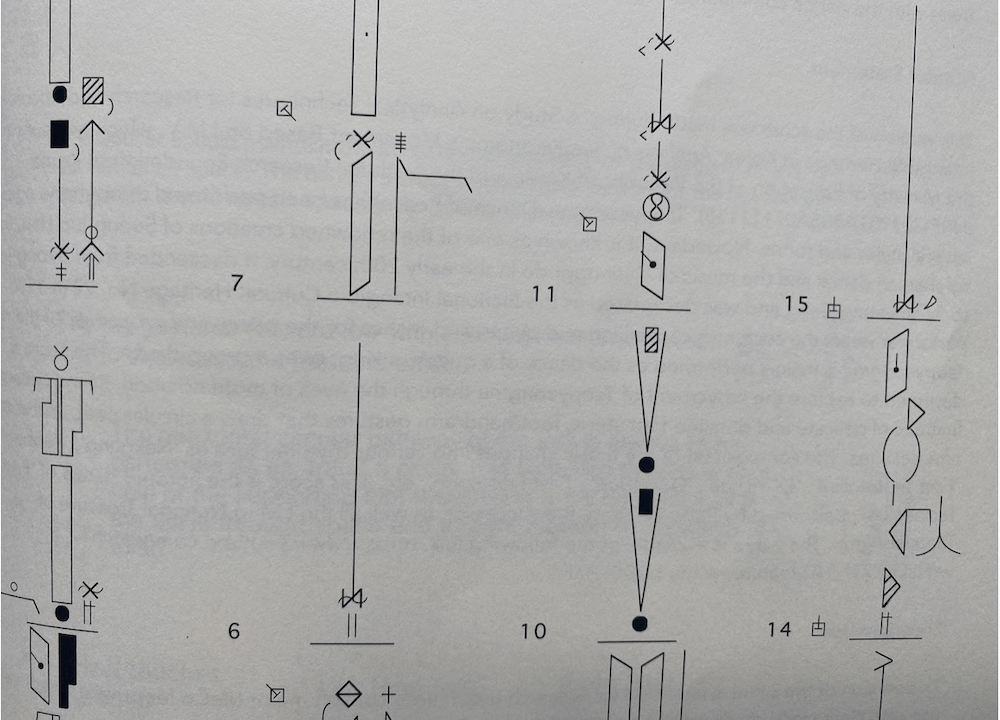
Chateau choreographed by Beth Megill, notated by Gabe Valentine, Portable Dances Volume 1
________________________________
Brendan McCall: Well, I was hoping this book and subsequent volumes would be some portable paperback book. I could stick it in my backpack or stick in my pocket and could read and enact or share it with other movers in a space easily. But I had to research Motif Description. There wasn't anything within the book itself saying what it is or offering a primer about how to read these symbols. I guess it's for other Motif Notation practitioners, which I'm not, so how do I encounter the book?
Emilee Lord: Yeah. No introduction offering an approach makes its claim to have accessibility in mind fall short because it doesn't let laypeople enter. I question the word "portable" because it's a rather large book and not very sturdy. So it doesn't feel portable as an object and doesn't feel like the dances within it are portable outside of the Motif Notation community.
BM: Correct. I find that odd. It says it has accessibility in mind on the back cover. Well… accessible to whom? And also, because it's dealing with scores, I find it almost ironic because a score, at least as I understand it, is a way to topple a kind of hierarchy of art creation, specifically dance. It's not from this centralized, individual mind; instead, a score is trying to democratize that process and say, well, here are some ideas. Go!
EL: Well, that depends on the kind of score. Maybe notation and scores are separate things, so how do we talk about both? Because one feeds into the other. And look, when discussing books, it's always necessary to examine for whom it's written. They framed the book like it was for everyone. It’s at odds with itself. It wants this very precious specificity of language and seemingly this opening of movement generation from an idea place that the post-modern score can do. And I don't think you can have both. (There are various forms of score making, from the graphic score to the instructional score, traditional music composition scoring, to the lesser known forms of dance notation. In what art historical context does this work place itself?)
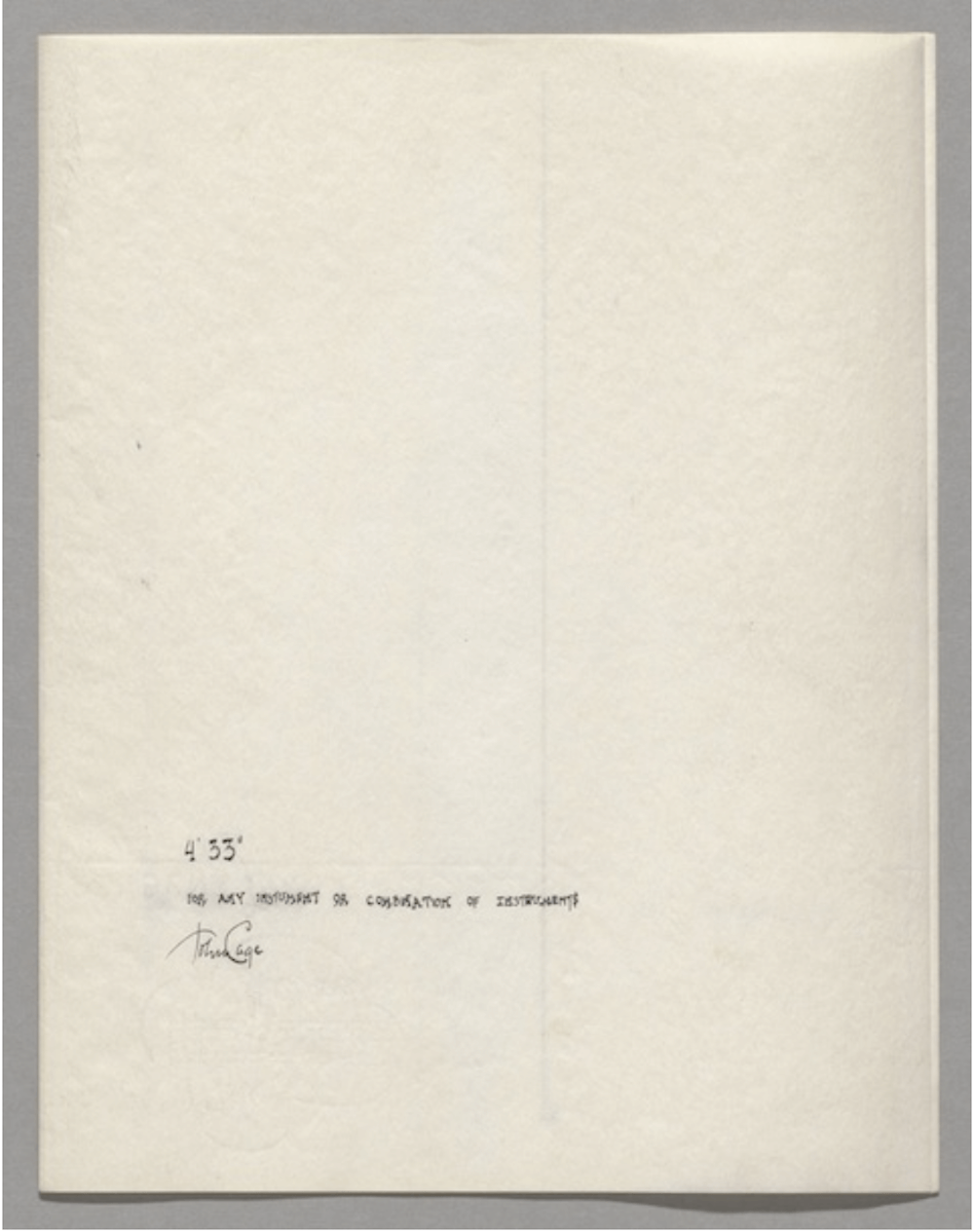
The score for John Cage’s famously silent composition 4’33”
BM: I'm thinking of how when scores, at least in dance, were first created,(it was) a definitive point in the United States… around the 1960s. If we can look at Robert Dunn, coming out of folks from that period like John Cage, Merce Cunningham into the Judson Church. That moment. Artists like Steve Paxton and Trisha Brown, and others were all trying to find ways to change the hierarchical, modern approach to dance making. They often found movement languages and forms that were purposefully ordinary, like walking, running, and standing, something that the majority of the public could do as a way to say, why are we going to these schools for 15 years to learn how to move? I mean, we know how to move. We're born moving.
EL: So that topples the hierarchy of choreographer to the performer and also the virtuosic body of the trained mover. Right?
BM: And it also eliminates this gulf between dancing for fun and dancing for art because with contact improvisation, as an example, you're saying anyone can learn the basics of that as quickly as teaching someone the rules of a card game. So that challenges this notion that dance is some rarefied activity that only people who have the financial means and the time are approved of by masters in this form.
EL: The gatekeepers, we should say.
BM: Yes. And the same thing in music. John Cage remains a radical artist because he says everyone is a musician. He's like Joseph Beuys in that way - everyone is an artist. And that means you don't need to go to Juilliard to become a musician, and you don't need to go to Berklee to become a singer. You only need a stopwatch. And that's threatening–to establishments, to institutions, to hierarchies. I´m thinking of that recording of Cage's retrospective at Carnegie Hall. The prepared piano pieces, the machines. At the end of the concert recording, you hear thunderous applause and loud booing go back and forth for about five minutes. The live recording lets both reactions fight for final dominance in the ears and mind of the listener. I think we´re still there, years later...
EL: So let's put John Cage and Erik Satie versus each other for the sake of this conversation. John Cage opened the structure, allowing access, saying everyone can do this. There was a level of absurdity, a level of mundane operations. And, of course, that level of chance. And those things all exist in the work of Satie. To perform his work, however, you need to be highly trained in reading musical scores and reading musical scores that are complicated and left open to complex interpretations. You have to be a master craftsman at this thing to ultimately understand what I think is his humor embedded in the score. Take Vexations, a joke played on this mastery and the masters, but it requires great skill to execute. And so these two bodies of work are pretty beautiful, contain absurdity, human interpretation, and a significant amount of artistry. It's just that they both understood where they wanted to lie with it.
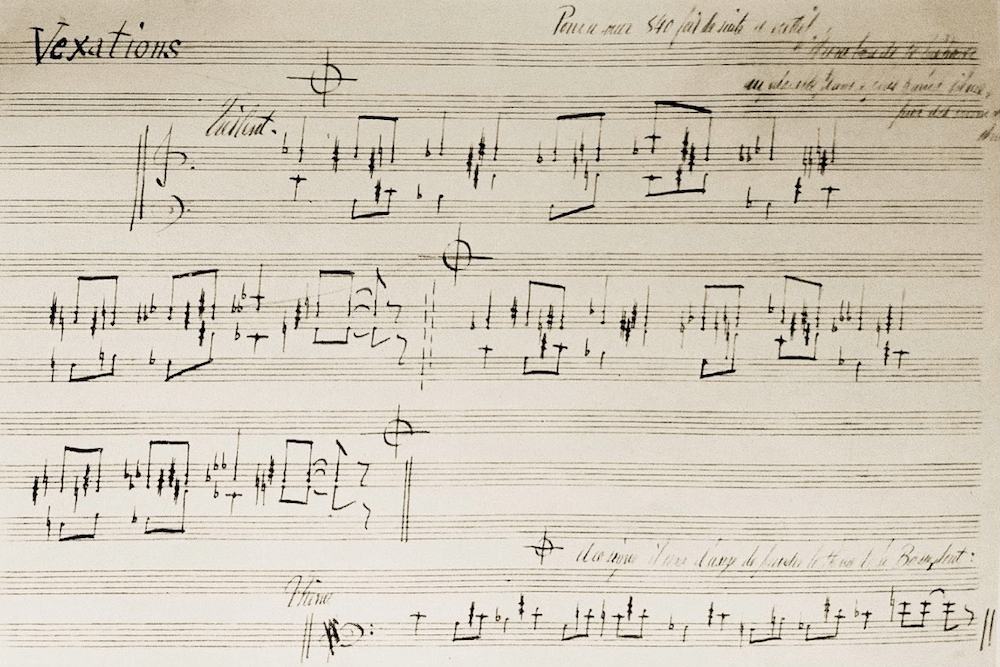
Vexations by Erik Satie
------------------------------------
In Merriam Webster, notation is a "...method of representing data by marks, signs, figures, or characters…." Beyond that, in Notations, edited by John Cage, Aaron Copeland wrote, "the writing down of musical thought is in every way as personal and revealing as the writing down of any thought. Examining a music manuscript, inevitably, I sense the man behind the notes. The fascination of a composer's notation is the fascination of human personality."
In this same compilation, Charles Wuorinen wrote, "composing is notating." These two statements intertwine the act of composing and that of notating as expressive of the individual doing it. Tohru Takemitsu calls notation "the verb of music." It takes a whole and unutterable experience and compresses it into Edward Tufte's flatland.
In Motion choreographed and notated by Corazon Tierra, Portable Dances Volume 2
Portable Dances volume 2 has a more unambiguous statement of intent than the first and positions itself in the world of Motif enthusiasts. In this volume, editor Beth Megill starts with some notes that provide more context for the work's mission. In these, she states, "The Notation process is itself a creative act…some scores stick to the basics while others push the envelope of motif theory…Each notator grapples to find the 'dance words' or concepts that best suit their goals."
While the mission and passion behind the project are more communicated in the second volume, I am still missing some notes on an approach that would lend itself to the wider dance community.
________________________________
BM: These books, 60 some odd years after Cage, ask for masters and public play and consumption. It's fascinating and problematic.
EL: Right. And this conversation is not to criticize the use of structure or language in scores in general or Language Of Dance specifically, but to criticize the accessibility and portability of this particular series and its intentions. And yet I loved going through this book with the glossary of Motif I have (which is pretty limited) and what I remember from studying this ages ago (which is also admittedly limited). It felt like a mental adventure, an exercise in thinking about the meaning and structure of language and notation. All the questions that came up. And I loved that activity and how one can embody this brain exercise here. That is, in fact, the point.
BM: I guess I'm less concerned with the transmission medium, with the brain exercise you described just now. Like, I just really want to get moving and have a good idea of how to get started on my feet as quickly as possible.
EL: You and I are far more familiar with engaging with scores like those found in iLanding, edited by Jennifer Monson. Instruction-based, open to interpretation, translatable to different spaces, etc. Maybe we are more Cage than Satie, and we're getting stuck. Maybe these books are not for us. And that’s ok. I would love to encourage those with Motif experience to play with these volumes. And I wish there was some kind of interactive online community built from this. Let’s say a hashtag or a place to upload your reading of whichever score because the beauty of this thing is how many ways it could unfold. As composer Alan Thomas said, "Notation is simply a drafting of a contract to be entered into by composer and performer for the benefit of the listener." (Notations, Cage, 1969) And I, the “listener,” stuck without enough know-how to dance them myself, would like to see the voices of these notators in motion.
Portable Dances a Motif Notation Chapbook Volumes 1 and 2, edited by Beth Megill, Megill and Company, 2021 and 2022
By Emilee Lord
July 29, 2022


